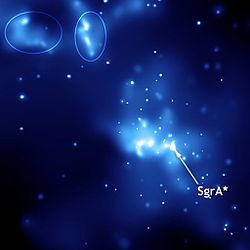Sagittarius A*
| Observation data Epoch J2000 Equinox J2000 |
|
|---|---|
| Constellation | Sagittarius |
| Right ascension | 17h 45m 40.0409s |
| Declination | −29° 0′ 28.118″ |
| Details | |
| Mass | (4.31 ± 0.38) × 106M☉ (4.1 ± 0.6) × 106 (4.02 ± 0.16) × 106 M☉ |
| Astrometry | |
| Distance | 7,940 ± 420 7,860±140±0.40pc |
Sagittarius A* (pronounced "Sagittarius A-star", standard abbreviation Sgr A*) is a bright and very compact astronomical radio source at the center of the Milky Way, near the border of the constellations Sagittarius and Scorpius. It is part of a larger astronomical feature known as Sagittarius A. Sagittarius A* is thought to be the location of a supermassive black hole, like those that are now generally accepted to be at the centers of most spiral and elliptical galaxies. Observations of the star S2 in orbit around Sagittarius A* have been used to show the presence of, and produce data about, the Milky Way's central supermassive black hole, and have led to the conclusion that Sagittarius A* is the site of that black hole.
Astronomers have been unable to observe Sgr A* in the optical spectrum because of the effect of 25 magnitudes of extinction by dust and gas between the source and Earth. Several teams of researchers have attempted to image Sagittarius A* in the radio spectrum using very-long-baseline interferometry (VLBI). The current highest-resolution measurement, made at a wavelength of 1.3 mm, indicated an angular diameter for the source of 37 μas. At a distance of 26,000 light-years, this yields a diameter of 44 million kilometers. For comparison, Earth is 150 million kilometers from the Sun, and Mercury is 46 million kilometers from the Sun at perihelion. The proper motion of Sgr A* is approximately −2.70 mas per year for the right ascension and −5.6 mas per year for the declination.
...
Wikipedia

